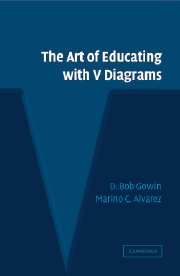Book contents
- Frontmatter
- Contents
- Foreword
- Preface
- Acknowledgment
- PART ONE FOUR COMMONPLACES OF EDUCATING PLUS ONE
- PART TWO THE V DIAGRAM
- PART THREE ANALYZING, EVALUATING, AND CONDUCTING RESEARCH
- PART FOUR REASONING WITH TECHNOLOGY
- 9 Electronic Educating
- Part 4 Summary
- Epilogue
- Appendices
- Bibliography
- Name Index
- Subject Index
9 - Electronic Educating
Published online by Cambridge University Press: 19 November 2009
- Frontmatter
- Contents
- Foreword
- Preface
- Acknowledgment
- PART ONE FOUR COMMONPLACES OF EDUCATING PLUS ONE
- PART TWO THE V DIAGRAM
- PART THREE ANALYZING, EVALUATING, AND CONDUCTING RESEARCH
- PART FOUR REASONING WITH TECHNOLOGY
- 9 Electronic Educating
- Part 4 Summary
- Epilogue
- Appendices
- Bibliography
- Name Index
- Subject Index
Summary
Principle 9. Electronic educating extends learning beyond the walls of the classroom or laboratory and enables meaning to be negotiated electronically in ways that go beyond the conventional paper-and-pencil formats.
Computer technologies have invaded modern societies in multiple ways. But as Professor Cuban concludes, computers have been “oversold and underused” in university life (2001). We believe his analysis is largely correct. The “killer applications” of computer technologies to university educating are still missing. We believe the failure lies in the lack of a coherent theory of educating. For the past eight years we have been using a theory to guide the changes in educative experience shared through email using reciprocal journaling. Electronic educating uses email – a computer-based interactivity between teachers, students, curriculum, governance, societal forces. Email is a powerful mode for negotiating meaning in ways that make educative events happen. Our theory of educating explains why some events are educative and most are not.
Electronic Literacy
Electronic literacy is a goal of electronic educating. Electronic literacy is grasping meanings expressed electronically. By electronic we mean information that appears in multiple formats on a screen in print and nonprint forms accessed via the Web. Electronic literacy requires the application of problem-solving and comprehension skills necessary to derive meaning and make judgments. Literacy is a word that represents events of using already-grasped meanings to grasp meanings not one's own. Reading a book is an example of grasping meanings in order to grasp new meanings. Electronic literacy is the same.
- Type
- Chapter
- Information
- The Art of Educating with V Diagrams , pp. 167 - 191Publisher: Cambridge University PressPrint publication year: 2005



